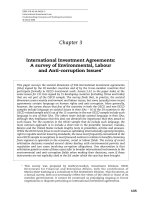Basic Concepts and Terminology
Bạn đang xem bản rút gọn của tài liệu. Xem và tải ngay bản đầy đủ của tài liệu tại đây (3.58 MB, 59 trang )
HCM City Univ. of Technology, Faculty of Mechanical Engineering Nguyen Tan Tien
1. BASIC CONCEPTS AND
TERMINOLOGY
Control System Technology 1.01 Basic Concepts and Terminology
HCM City Univ. of Technology, Faculty of Mechanical Engineering Nguyen Tan Tien
Control System Technology 1.02 Basic Concepts and Terminology
HCM City Univ. of Technology, Faculty of Mechanical Engineering Nguyen Tan Tien
§1. Introduction
- A control system is a group of components that maintains a desired result by
manipulating the value of another variable in the system
- Example: I. Polzunov’s water level float regulator - 1765
Control System Technology 1.03 Basic Concepts and Terminology
HCM City Univ. of Technology, Faculty of Mechanical Engineering Nguyen Tan Tien
§1. Introduction
- Example: Wall’s fly-ball governor - 1769
Control System Technology 1.04 Basic Concepts and Terminology
HCM City Univ. of Technology, Faculty of Mechanical Engineering Nguyen Tan Tien
§2. Block Diagrams and Transfer Functions
- The block diagram (sơ đồ khối) is a method of representing a control system that
retains only this important feature of each component
- Signal lines (đường tín hiệu) indicate the input and output signals of the
component
- The energy source is not shown on block diagrams. However, many components
do have an external energy source that makes amplification of the input signal
possible
Control System Technology 1.05 Basic Concepts and Terminology
HCM City Univ. of Technology, Faculty of Mechanical Engineering Nguyen Tan Tien
§2. Block Diagrams and Transfer Functions
2.1 Block diagrams
- A block diagram consists a block representing each component in a control
system connected by lines that represent the signal paths
- Example: An simple block diagram of a person driving an automobile
Control System Technology 1.06 Basic Concepts and Terminology
HCM City Univ. of Technology, Faculty of Mechanical Engineering Nguyen Tan Tien
§2. Block Diagrams and Transfer Functions
2.1 Block diagrams
- Example: Block representations of various components
• Thermocouple temperature sensor: a thermocouple is a junction between two
different metals that produces a voltage related to a temperature difference
Control System Technology 1.07 Basic Concepts and Terminology
HCM City Univ. of Technology, Faculty of Mechanical Engineering Nguyen Tan Tien
§2. Block Diagrams and Transfer Functions
2.1 Block diagrams
• Amplifier: an amplifier or simply amp, is a device for increasing the power of a
signal
Control System Technology 1.08 Basic Concepts and Terminology
HCM City Univ. of Technology, Faculty of Mechanical Engineering Nguyen Tan Tien
§2. Block Diagrams and Transfer Functions
2.1 Block diagrams
• DC Motor
Control System Technology 1.09 Basic Concepts and Terminology
HCM City Univ. of Technology, Faculty of Mechanical Engineering Nguyen Tan Tien
§2. Block Diagrams and Transfer Functions
2.1 Block diagrams
• Valve: valve is used to control flow rate by opening/closing the gate position
response to signals received from controllers
Control System Technology 1.10 Basic Concepts and Terminology
HCM City Univ. of Technology, Faculty of Mechanical Engineering Nguyen Tan Tien
§2. Block Diagrams and Transfer Functions
2.1 Block diagrams
• Liquid flow transmitter: a device used to measure the flow of liquids in
pipelines and convert the results into proportional electric signals
Control System Technology 1.11 Basic Concepts and Terminology
HCM City Univ. of Technology, Faculty of Mechanical Engineering Nguyen Tan Tien
§2. Block Diagrams and Transfer Functions
2.1 Block diagrams
• Driver of automobile
Control System Technology 1.12 Basic Concepts and Terminology
HCM City Univ. of Technology, Faculty of Mechanical Engineering Nguyen Tan Tien
§2. Block Diagrams and Transfer Functions
2.1 Block diagrams
• Automobile power steering unit: steering is the term applied to the collection of
linkages which will allow a vehicle to follow the desired course
Control System Technology 1.13 Basic Concepts and Terminology
HCM City Univ. of Technology, Faculty of Mechanical Engineering Nguyen Tan Tien
§2. Block Diagrams and Transfer Functions
2.1 Block diagrams
• Automobile
Control System Technology 1.14 Basic Concepts and Terminology
HCM City Univ. of Technology, Faculty of Mechanical Engineering Nguyen Tan Tien
§2. Block Diagrams and Transfer Functions
2.2 Transfer functions
- The most important characteristic of a component is the relationship between
the input signal and the output signal. This relationship is expressed by the
transfer function of the component
- A transfer function () is defined as the output divided by the input
- Steady state values for the , which is sometimes called simply the gain
Control System Technology 1.15 Basic Concepts and Terminology
HCM City Univ. of Technology, Faculty of Mechanical Engineering Nguyen Tan Tien
§2. Block Diagrams and Transfer Functions
2.2 Transfer functions
- Example: A potentiometer is used as a position sensor. The pot is configured in
such a way that
of rotation yields and
yields . Find the transfer
function of the pot
Solution
The transfer function is output divided by input. In this
case, the input to the pot is “position in degrees” and
output is volts
The transfer function of a component is an extremely
useful number. It allows you to calculate the output of
a component if you know the input
Control System Technology 1.16 Basic Concepts and Terminology
HCM City Univ. of Technology, Faculty of Mechanical Engineering Nguyen Tan Tien
§2. Block Diagrams and Transfer Functions
2.2 Transfer functions
- Example: For a temperature-measuring sensor, the input is temperature, and the
output is voltage. The sensor transfer function is given as . Find the
sensor output voltage if the temperature is
Solution
The sensor output voltage if the temperature is
- can be a series of connection
Control System Technology 1.17 Basic Concepts and Terminology
HCM City Univ. of Technology, Faculty of Mechanical Engineering Nguyen Tan Tien
§2. Block Diagrams and Transfer Functions
2.2 Transfer functions
- can be a parallel of connection
- can be a feedback connection
Control System Technology 1.18 Basic Concepts and Terminology
HCM City Univ. of Technology, Faculty of Mechanical Engineering Nguyen Tan Tien
§3. Open-Loop Control
- An open-loop control system utilizes an actuating device to control the process
directly without using feedback
- An open loop control system does not compare the actual result with the desired
result to determine the control action
- An calibrated setting, previously determined by some sort of calibration procedure
or calculation, is need to obtain the desired result
Control System Technology 1.19 Basic Concepts and Terminology
HCM City Univ. of Technology, Faculty of Mechanical Engineering Nguyen Tan Tien
§3. Open-Loop Control
- Example: A simple robot arm open-loop position system
Control System Technology 1.20 Basic Concepts and Terminology
HCM City Univ. of Technology, Faculty of Mechanical Engineering Nguyen Tan Tien
§3. Open-Loop Control
- Example: The system consists of an electric motor driving a gear train, which is
driving a winch. The motor turns at
for each volt (
) supplied. The
output shaft of the gear train rotates at of the motor speed. The winch (with a
shaft circumference) converts the rotary motion (
) to linear speed.
Control System Technology 1.21 Basic Concepts and Terminology
HCM City Univ. of Technology, Faculty of Mechanical Engineering Nguyen Tan Tien
§3. Open-Loop Control
Solution
The transfer function of the whole system
or
We have shown that the transfer function of the complete system
Knowing this value, we can calculate the system output for any system input. For
example, if the input to the this system is (to the motor), the output speed of
the winch is calculated as follows
Control System Technology 1.22 Basic Concepts and Terminology
HCM City Univ. of Technology, Faculty of Mechanical Engineering Nguyen Tan Tien
§4. Closed-Loop Control
- A closed-loop control system uses a measurement of the output and feedback of
this signal to compare it with the desired output (reference or command)
Open-loop control
Closed-loop control
- In a closed-loop control system, the output of the process (controlled variable) is
constantly monitored by a sensor
Control System Technology 1.23 Basic Concepts and Terminology
HCM City Univ. of Technology, Faculty of Mechanical Engineering Nguyen Tan Tien
§4. Closed-Loop Control
- Example: A simple robot arm closed-loop position system
Open-loop control
Closed-loop control
Control System Technology 1.24 Basic Concepts and Terminology
HCM City Univ. of Technology, Faculty of Mechanical Engineering Nguyen Tan Tien
§4. Closed-Loop Control
Control System Technology 1.25 Basic Concepts and Terminology









